Inverness Deanery
Dunlichty
Parish Church: OS Ref: NGR NH 660330 H.E.S. No: NH63NW 56 Dedication: St Finan of Clonard.
Associated Chapels: Dunmaglass {NGR NH 609239}; Brinmore {NGR NH 664289}; Loch a'Chlachain {NGR NH 65_32_}
This church is often referred to in charters as Lundichty and, somewhat less regularly, as Londechty, Lunlichty and Lindochty. The loch to the south-west of Dunlichty Lodge is Loch Chlachain, "the Loch of the Church", {NGR NH 655325}, which, along with other ancient remains, indicates that there was a settlement of substantial proportions in this locality.
In all probability St Finan of Clonard was titular of the ancient parish of Dunlichty. Till 1643 a wooden image of the saint was preserved in the parish, and held in much esteem, but it was burned at the market cross of Inverness on December 21st of that year.1
The original church of this area was a foundation of the Early Church. It was situated a little distance to the south at Brinmore {NGR NH 664290} on the south side of Creagan an Tuirc ("the boar rock"). Traces of a burial ground have been reported.2
A local story, and it is an old one, relates that at one time a new laird, who lived at Dunlichty, took over all of Strath Nairn. He wanted the church near to his residence and so he had one built. He took the bell from the old church at Brinmore to the new one he had built but, as often as he would have it taken to the east, so it would return to Brinmore tolling to the words "Glag Fhinnan" (Finnan's Bell). The laird had it chained but it broke the chain. At last, he left the bell at Brin and it disappeared. It is said that since then the Strath has neither been so fertile or health. 3
"As far as is known, there were five churches in Strath Nairn in the days of the Celtic Church. There was the one ... at Brinmore {NGR NH 664289} behind Creagan an Tuirc on the summit of which are the remains of a hillfort. Bones were dug up there in the course of land improvement last century. There was a church at Daviot {NGR NH 724394}. Another was at Mid Lairgs {NGR NH 714364}, the site of which is no more as the quarry operations there have obliterated every trace of it. There is said to have been one at Dunmaglass but its site is now unknown {c.NGR NH 609238}. The stones of one at Bunachton {NGR NH 658344} are still to be seen and two names in connection with it - Cathair an t-Sagairt, "the priest's chair"; and Tobar an t-Sagairt, "the priest's well" - are still known. The site was either at Bunachton or Midtown just to the south -west. When the corn 'breared', the marks of old graves could be seen. {crop-marks}"4 This church lay on the very north-east extremity of Dores parish.
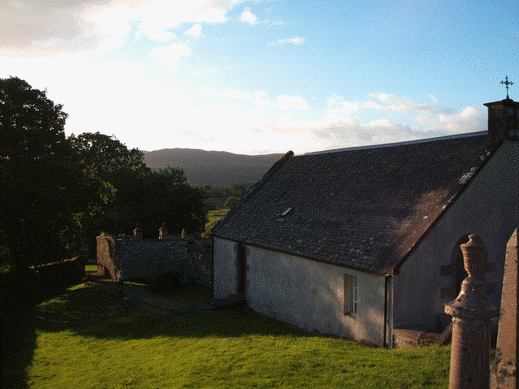
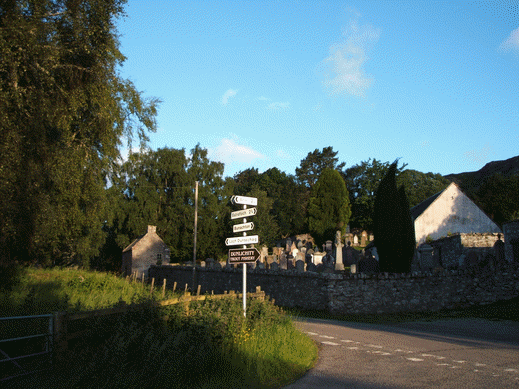
Above: Dunlichty Church.
It is not certain when the parish church was moved to Dunlichty. A church was built there in 1569 and this was replaced by another in 1759, which has been much repaired since. There is evidence of there having been a community at this site from ancient times, including cup-marked stones in both the churchyard and at Dunlichty Farm {NGR NH 659327}, a cairnfield and a hut circle.. There is a known 'township' at Balnaclach with the remains of about 15 buildings, kilns and huts. The lands about this township were known as Drumboy and they are also known to have been part of the 'castlelands' of Inverness.5 Control of the patronage of the church was contested between the earls of Crawford and Moray in the fifteenth-century (vide infra), the latter apparently being successful in his claim to the right. The patronage was still in the hands of his successors in the sixteenth-century.6 During the whole of its history Dunlichty was an 'independent' church, i.e. it was not appropriated in any way, and had a rector to serve the cure. This is quite unusual in the diocese of Moray.
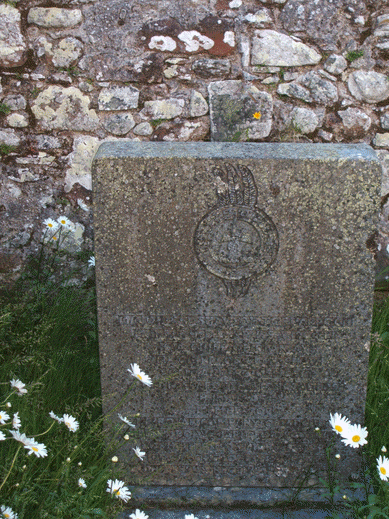
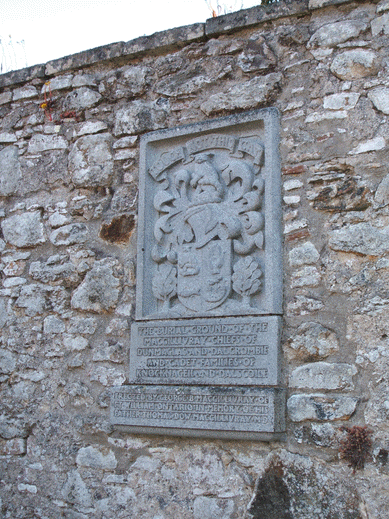
Above: (left) Grave of Shaw of Tordarroch; (right)Burial-place of the Chiefs of MacGillivray.
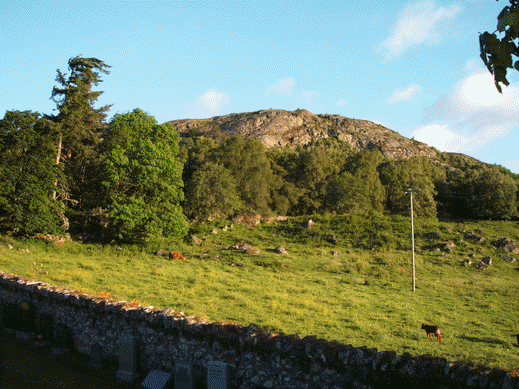
Above: The view from the graveyard at Dunlichty with Creag a Clachain in the bckground.
The matter of the lands of Dunlichty is somewhat confused and the situation is not helped by the fact that Ross, in his thesis,8 chose to treat Daviot and Dunlichty together, even though the two parishes were not joined until after the Reformation.7 However, using the data that he provides, it is possible to speculate which of the lands that he lists belonged to Dunlichty. These are shown in the table below.
| Name | OS Grid Ref. | Extent | Comment |
|---|---|---|---|
| Drumboy | NH 66_32_ | (unknown) | Includes the township of Balnaclach. |
| Meikle Aberarder | c.NH 621255 | 1 dabhach | |
| Little Aberarder | c.NH 621255 | 1 dabhach | |
| Meikle Brins | c.NH 666293 | 1 dabhach | |
| Little Brins | c.NH 666293 | 1 dabhach | |
| Dunmaglass | NH 593223 | 1 dabhach | |
| Dunlichty | NH 659328 | 1 dabhach | |
| Tordarroch | NH 677335 | 1 dabhach | |
| Bunachton | NH 658344 | (2 arratras) | Just lies in Dores parish. |
Clergy:
1428 Robert Breci, rector of Lundechty, had died by this date. (vide infra)
1428 (11 August) Formerly, on the voidance of the parish church of Lundechty [Dunlichty], Moray diocese, by the death outwith the Roman Court of Robert Breci, last true rector and possessor, Alexander Earl of Crawford presented Walter Blar, priest, Moray diocese, and then the Earl of Moray presented another to the said church within the statutory time, each of the said Earls claiming the right of patronage as often as a vacancy occurred, and each of them petitioned the Bishop of Moray as Ordinary to admit his presentation. But the Bishop, seeing the controversy between the said Earls over the right of presentation, did not care to make a judgement and neglected to provide either presentee; on account of which it is alleged by some that collation has devolved to the Apostolic See. Walter (Blair), who is M.A., therefore supplicates that the Pope would provide him to the said parish church of Lundechti (value 20 marks sterling), notwithstanding a canonry and prebend of Moray (20 marks sterling) which he holds, and an Expectative Grace and dispensation to incompatibles.
Fiat ut petitur. O. Fiat.
Genazzano, Palestrina diocese, 3 Id. Aug., anno 11.
[CSSR, ii (1423-1428), p.236]
Walter is recorded as holding the canonry and prebend of Inverkeithny in Elgin cathedral, in 1428, 1429 and 1430. This episode illustrates the ongoing feud between the two earls regarding the patronage of this church.
1. Mackinlay, J.M. (1914) Ancient Church Dedications in Scotland: Non-Scriptural Dedications. Edinburgh: David Douglas. p.83
2. 3rd Statistical Account, p.42
3. "The Transactions of the Gaelic Society of Inverness"(TGSI), vol.51 (1978-80), p.496. This sounds very like a saint's handbell - it was small enough to be transported - and could well have been St Finnan's own bell.
4. ibid.
5. HES Canmore Database https://canmore.org.uk/site/78543/dunlichity (visited 10/08/19).
6. Fawcett, R. and Oram, R. (2001) Elgin Cathedral and the Diocese of Moray. Edinburgh: Historic Scotland (now Historic Environment Scotland). p.129
7. Most scholars, including Lachlan Shaw, believe that the two parishes were united around 1618.
8. Ross, A.D. (2003) The Province of Moray, c.1000-1230. Unpublished PhD Thesis presented to Aberdeen University. p.66-67
e-mail: admin@cushnieent.com
© 2019 Cushnie Enterprises
